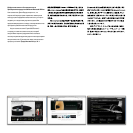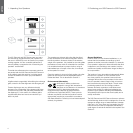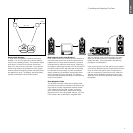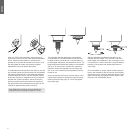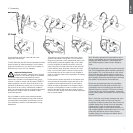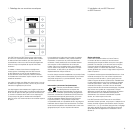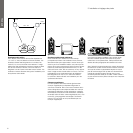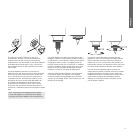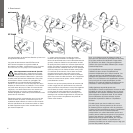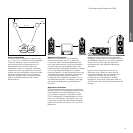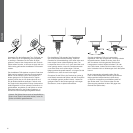
8
ENGLISH
6. Running In5. Fine Tuning
Before ne tuning, double check that all the
connections in the installation are correct and secure.
Moving the speakers further from the walls will
reduce the general level of bass. Space behind the
speakers also helps to create an impression of depth.
Conversely, moving the speakers closer to the walls will
increase the level of bass and potentially reduce the
impression of depth.
If the bass is uneven with frequency, it is usually due to
the excitation of resonance modes in the room. Even
small changes in the position of the speakers or the
listeners can have a profound effect on how these
resonances affect the sound. Try positioning the
speakers along a different wall. Even moving large
items of furniture can have an effect.
If the sound is too harsh, increase the amount of
soft furnishing in the room (for example, use heavier
curtains), or reduce it if the sound is dull and lifeless.
Test for utter echoes by clapping your hands and
listening for rapid repetitions. Reduce utter echoes
by the use of irregular shaped surfaces such as
bookshelves and large pieces of furniture.
For the most discerning listening, remove the bass and
midrange grilles by gripping around their edges and
gently pulling them away from the cabinet.
The performance of your speakers may change subtly
during the initial listening period. If they have been
stored in a cold environment, the damping compounds
and suspension materials of the drive units will
take some time to recover their correct mechanical
properties. The drive unit suspensions will also loosen
up during the rst hours of use. The time taken for
the speakers to achieve their intended performance
will vary depending on previous storage conditions
and how it is used. As a guide, allow up to a week
for the temperature effects to stabilise and 15 hours
of average use for the mechanical parts to attain their
intended design characteristics.
Longer run-in periods (as long as a month) are also
sometimes reported and there is evidence to suggest
that these have little to do with speakers changing and
more to do with listeners becoming familiar with the
new sound. This is especially so with highly revealing
speakers such as the 800 Series Diamond, where
there may be a signicant increase in the amount
of musical detail compared with what listeners have
previously been used to.
800 Series Diamond cabinet surfaces will usually only
require dusting. We recommend you use the cloth
supplied with the product. If you wish to use an aerosol
or other cleaner, apply the cleaner onto the cloth, not
directly onto the product and test a small area rst,
as some cleaning products may damage some of the
surfaces. Avoid products that are abrasive, or contain
acid, alkali or anti-bacterial agents. Do not use cleaning
agents on the drive units. Avoid touching the drive units
as damage may result.
Whenever Bowers & Wilkins speakers are nished
in real wood, the nest veneers are selected and
treated with an ultra-violet resistant lacquer to
minimise changes in colour over time. Nevertheless,
like all natural materials, the veneer will respond to
its environment and a degree of colour change is to
be expected. Colour differences may be rectied by
exposing all the veneer surfaces equally and evenly
to sunlight until the colour is uniform. This process
can take several days or even weeks, but may be
accelerated by careful use of an ultra-violet lamp.
Wood veneered surfaces should also be kept away
from direct sources of heat such as radiators and
warm air vents in order to minimise the possibility of the
wood veneer cracking.
7. Aftercare





